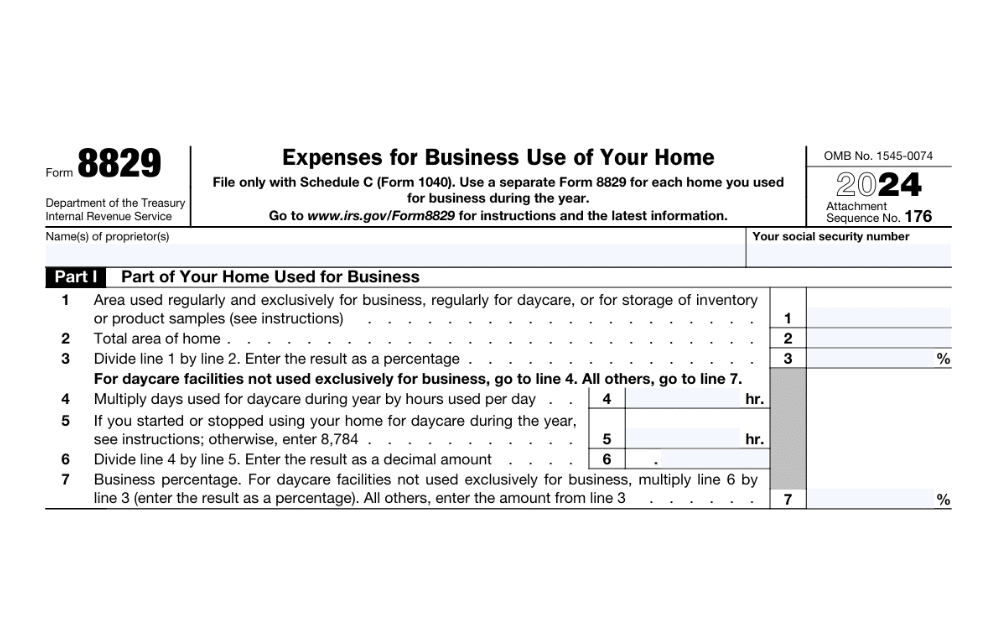Form 8829 for American Expats: When Do You Need This Form?

- Do I Need Form 8829 or Can I Use the Simplified Method?
- What Expenses Can I Claim on Form 8829 as an Expat?
- How Do I Complete Form 8829 Step by Step?
- How to File Form 8829
- How Does Form 8829 Work with My FEIE and Foreign Tax Credit?
- What Documentation Do I Need as an Expat?
- Can I Use Form 8829 If I Move Between Countries?
- What Mistakes Should I Avoid?
- Should I File Form 8829 or Get Professional Help?
Form 8829 is used to figure the allowable expenses for business use of your home on Schedule C (Form 1040) and any carryover to next year of amounts not deductible this year, and the good news is this applies equally whether your home office is in Manhattan or Manila. As an American expat working from abroad, you have the same opportunity to claim business home expenses, and often the savings are more substantial than the simplified $5-per-square-foot method.
Form 8829 is how you claim the actual expense method for home office deductions when you’re self-employed abroad. This form calculates your allowable business deductions and transfers the final amount to Schedule C, line 30. For many expats with significant home expenses, Form 8829 provides larger deductions than the simplified method, and it can coordinate strategically with your Foreign Earned Income Exclusion or Foreign Tax Credit.
Do I Need Form 8829 or Can I Use the Simplified Method?
You have two options for claiming home office deductions as a self-employed expat:
Simplified Method (No Form 8829 Required):
- Deduct $5 per square foot up to 300 square feet
- Maximum deduction: $1,500
- Report directly on Schedule C, line 30
- Minimal documentation required
Actual Expense Method (Requires Form 8829):
- Calculate actual home expenses allocated to business use
- Often results in deductions exceeding $1,500
- Must file Form 8829 with detailed records
- Can depreciate foreign property (if owned)
You should use Form 8829 if:
- Your allocated home expenses exceed $1,500 annually
- You own foreign property and want to claim depreciation
- You have substantial direct business expenses for your office space
- You need to carry forward unused deductions from previous years
Most expats with dedicated office spaces and significant home expenses benefit more from Form 8829 than the simplified method.
What Expenses Can I Claim on Form 8829 as an Expat?
Form 8829 divides business expenses into two categories:
Direct Expenses (100% Deductible):
- Repairs or improvements to your office space only
- Business-specific furniture or equipment for the office
- Separate business phone lines are installed in your office
- Office-only internet connections
Indirect Expenses (Deductible Based on Business Percentage):
- Rent payments (very common for expats)
- Utilities (electricity, water, heating, internet)
- Property taxes (if you own foreign property)
- Homeowners’ or renters’ insurance
- General repairs and maintenance
- Depreciation (for owned foreign properties)
These home office expenses are separate from other business deductions available to expats, such as travel, equipment, and professional services, which are claimed directly on Schedule C.
All foreign currency expenses must be converted to USD using the appropriate exchange rates. The IRS accepts various conversion methods but requires consistency throughout the tax year.
How Do I Complete Form 8829 Step by Step?
Form 8829 is a one-page form divided into four parts that work together to calculate your home office deduction. Here’s how to complete each section:
Part I: Calculate Your Business Use Percentage
Step 1: Measure your office space in square feet (Line 1)
- If your lease lists square meters, multiply by 10.764 to convert
- Only count the space used regularly and exclusively for business
Step 2: Measure your total home square footage (Line 2)
- Include all living space, but not garages or unfinished areas
Step 3: Calculate the percentage (Line 3)
- Divide Line 1 by Line 2, then multiply by 100
- Example: 200 sq ft office ÷ 1,000 sq ft home = 20% business use
Step 4: Enter your business percentage on Line 7
- This percentage applies to all indirect expenses throughout the form
- Skip Lines 4-6 unless you operate a daycare facility
Part II: Figure Your Allowable Deduction
Line 8: Enter your business income from Schedule C, Line 29
- Add any gains from the business use of your home
- Subtract any business losses not related to home use
Lines 9-23: Enter your home expenses
- Direct expenses (Column a): 100% deductible business-only costs
- Indirect expenses (Column b): Home expenses shared between business and personal use
Lines 24-36: Calculate your allowable deduction
- Multiply indirect expenses by your business percentage from Line 7
- Apply income limitations to prevent deducting more than you earned
- The final amount on Line 36 transfers to Schedule C, Line 30
Part III: Depreciation of Your Home
Lines 37-42: Calculate depreciation if you own your foreign property
- Determine the smaller of the cost basis or the fair market value
- Calculate the business basis using your business percentage
- Apply depreciation rates according to IRS guidelines
- Important: Foreign property depreciation involves complex international considerations
Part IV: Carryover of Unallowed Expenses
Lines 43-44: Calculate expenses to carry forward to 2025
- If your expenses exceed your income limitation, the excess carries over
- These amounts can reduce future tax bills when you have sufficient business income
- Carryovers remain available even if you move to a different country

How to File Form 8829
- Complete all applicable sections of Form 8829
- Transfer the final deduction from Line 36 to Schedule C, Line 30
- Attach Form 8829 to your tax return when you file
- File by the deadline: June 15 for expats (October 15 with extension)
- Keep detailed records of all expenses and square footage calculations
Whether you’re years behind or just unsure about the thresholds, our team is ready to help.
How Does Form 8829 Work with My FEIE and Foreign Tax Credit?
Form 8829 deductions reduce your Schedule C profit before applying expat benefits:
Foreign Earned Income Exclusion:
Form 8829 reduces your business income, potentially allowing you to exclude more under the $130,000 FEIE limit for 2025.
Example: Maria earns $135,000 from consulting in Berlin with $8,000 in Form 8829 deductions.
- Before Form 8829: $135,000 income, $5,000 subject to tax after FEIE
- After Form 8829: $127,000 income, $0 subject to tax (all excluded under FEIE)
Foreign Tax Credit:
If you pay significant foreign taxes, Form 8829 deductions reduce your US tax liability directly. You can then apply the Foreign Tax Credit to any remaining tax, potentially creating carryover credits for future years.
What Documentation Do I Need as an Expat?
Essential Records for Form 8829:
- Foreign lease agreements or property deeds
- Utility bills in foreign currency with payment records
- Currency conversion documentation
- Photos showing exclusive business use
- Receipts for all direct business expenses
Can I Use Form 8829 If I Move Between Countries?
Yes, but special considerations apply:
- Multiple Homes in One Year: Use a separate Form 8829 for each home you used for the business during the year. This commonly occurs when expats relocate mid-year.
- Carryover Rules: Unused deductions from Form 8829 can be carried forward even if you move to a different country, as long as you continue the same business.
- Currency Considerations: When moving between countries with different currencies, maintain separate records for each location and convert consistently.
Form 8829 applies to permanent or long-term housing where you have a dedicated office space. Different deduction rules may apply to digital nomads working from temporary locations like Airbnbs.
What Mistakes Should I Avoid?
- Mixing Personal and Business Use: Your office must be used exclusively for business. The corner of your bedroom doesn’t qualify.
- Inconsistent Currency Conversion: Use the exact exchange rate method all year. IRS exchange rates provide a reliable standard.
- Forgetting Income Limitations: You cannot deduct more than your business income. Excess amounts must be carried forward.
- Using Both Methods: Don’t claim both the simplified method and Form 8829 in the same year.
Should I File Form 8829 or Get Professional Help?
Form 8829 involves detailed calculations and coordinates with complex expat tax benefits. Consider professional assistance if:
- You own foreign property requiring depreciation calculations
- Your income fluctuates significantly between years
- You have unused expense carryovers from previous years
- You’re uncertain whether FEIE or Foreign Tax Credit works better with your deductions
The interaction between Form 8829, Form 2555 (FEIE), and Form 1116 (Foreign Tax Credit) requires careful planning to maximize your tax savings.
Form 8829 is one component of your comprehensive expat tax strategy. The key is coordinating all available deductions and credits to minimize your overall tax burden while maintaining compliance.
Remember: We’ve helped over 23,000 expats optimize their tax strategies across 190+ countries. Our team understands the complexities of Form 8829 and how it integrates with expat-specific benefits.
No matter how late, messy, or complex your return may be, we can help. Our CPAs and Enrolled Agents specialize in expat business taxes and will ensure you’re maximizing deductions while staying compliant with both US and foreign tax requirements.
Contact us, and one of our customer champions will gladly help. If you need specific advice on your tax situation, click below to get a consultation with one of our expat tax experts.
This article provides general information about Form 8829 for educational purposes. Tax situations vary significantly, and you should consult a qualified tax professional for specific advice.



